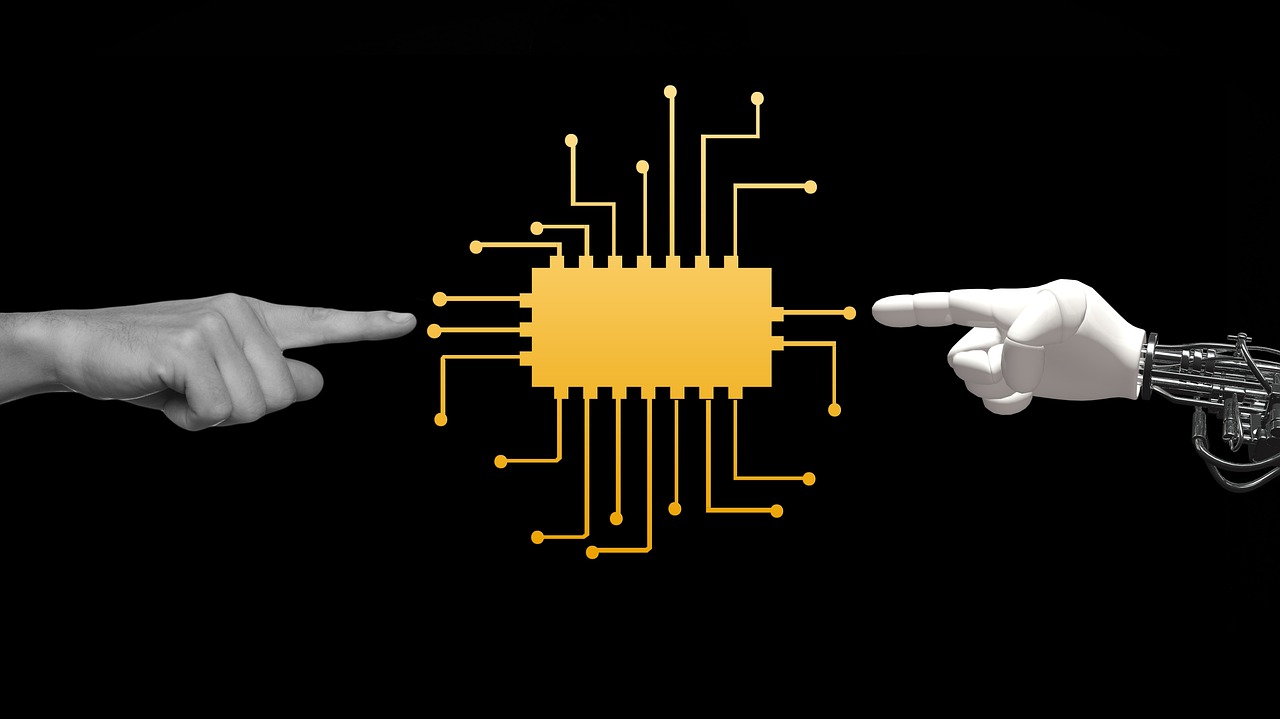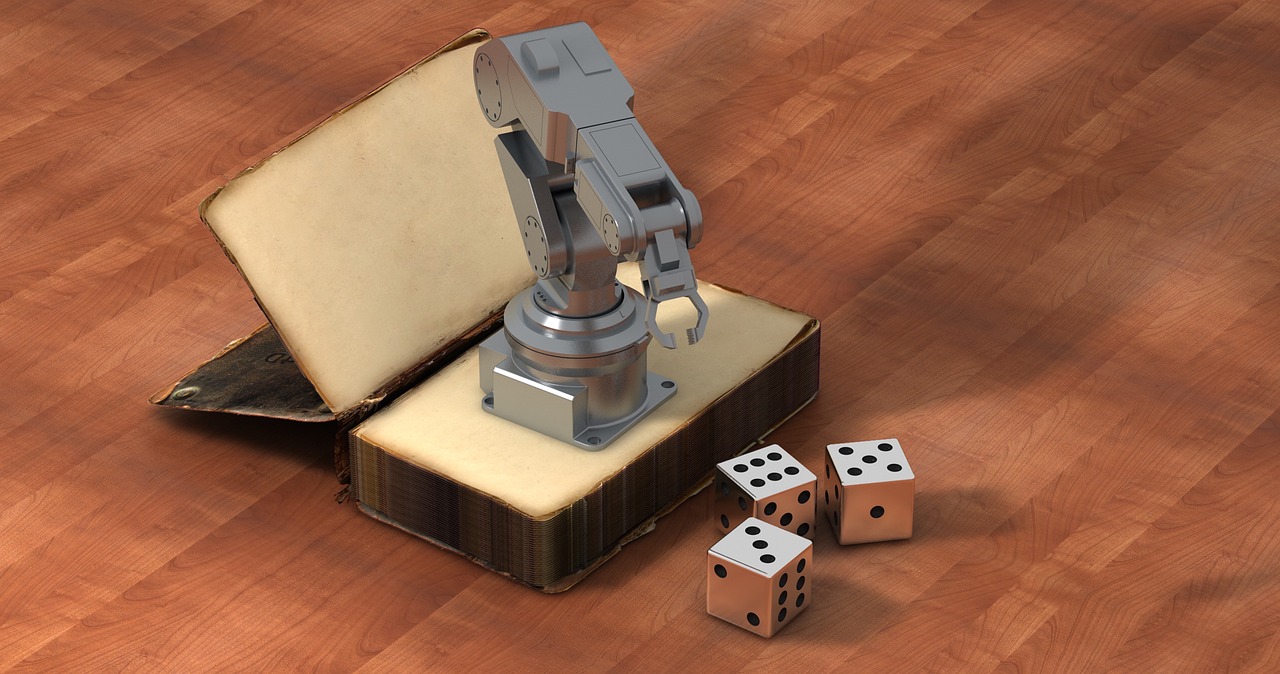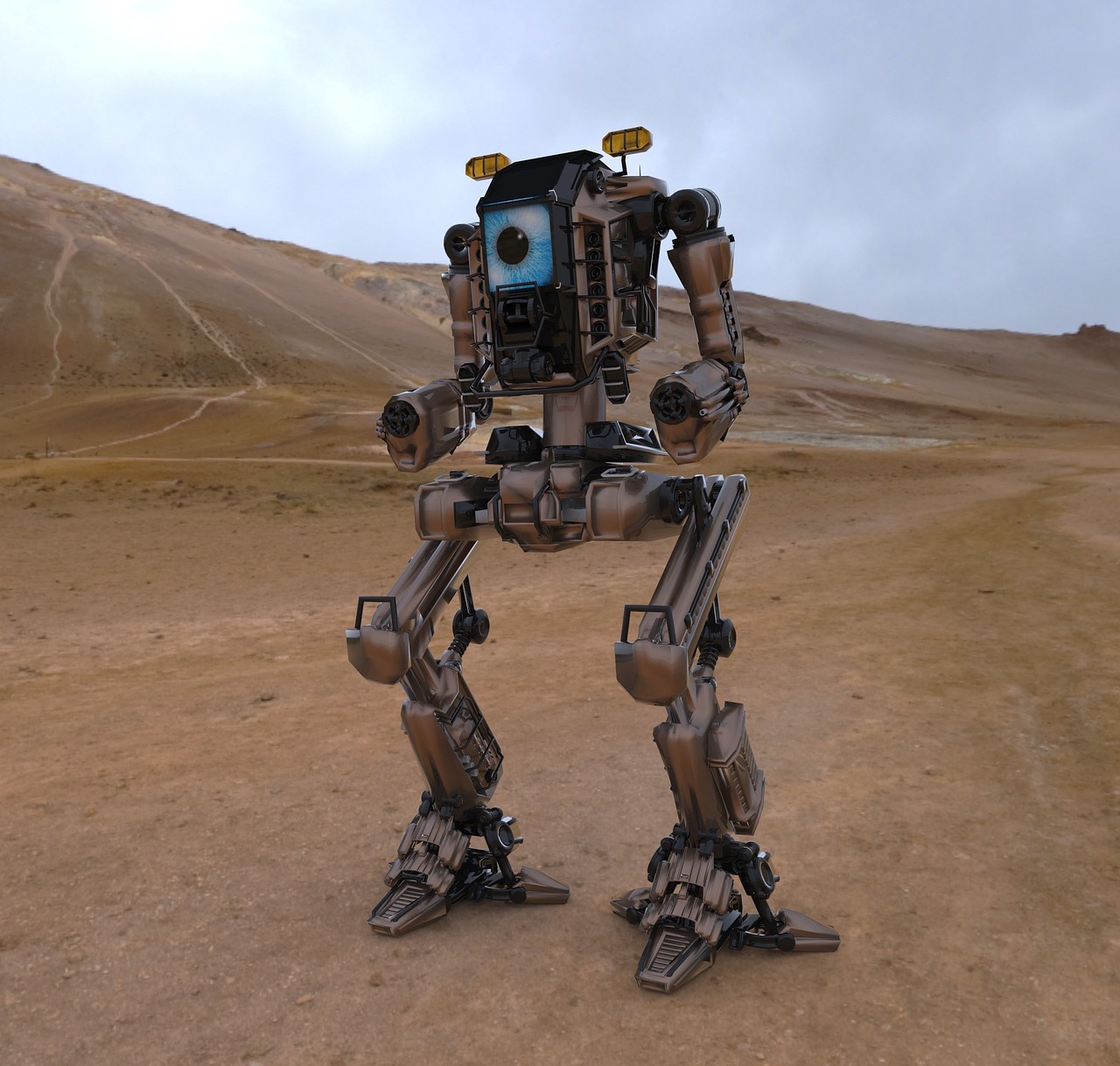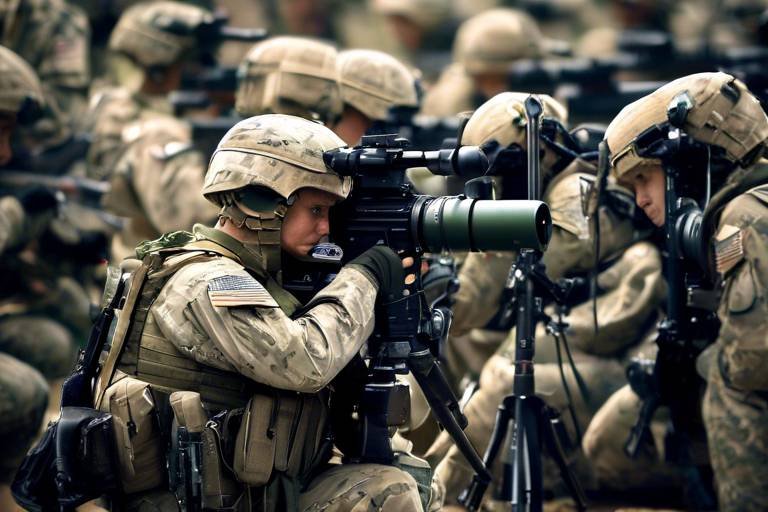The Role of Advanced Robotics in Defense Operations
In today's rapidly evolving world, the integration of advanced robotics into defense operations is nothing short of revolutionary. These sophisticated machines are not just futuristic concepts; they are actively enhancing the efficiency, safety, and effectiveness of military operations across the globe. Imagine a battlefield where robots can scout enemy positions, neutralize threats, and gather crucial intelligence, all while keeping human soldiers out of harm's way. This transformation is not only changing the way wars are fought but also reshaping military strategies for the future.
The role of robotics in defense is multifaceted. From unmanned aerial vehicles (UAVs) flying high above the battlefield to ground robots navigating treacherous terrains, these machines are designed to take on tasks that would be too dangerous or impractical for human personnel. As we delve deeper into this topic, we will explore the evolution of defense robotics, the various types of robots in use today, and the myriad benefits they bring to military operations. Moreover, we will address the challenges and limitations that accompany their deployment and look ahead to future trends that promise to further enhance their capabilities.
As we navigate through this complex landscape, it’s essential to recognize the profound implications that advanced robotics have on military operations. The potential for increased safety, operational efficiency, and mission success rates cannot be overstated. However, with these advancements come ethical considerations and technical challenges that must be carefully managed. In this article, we will not only highlight the impressive advancements in defense robotics but also engage with the critical conversations surrounding their use in warfare.
In summary, advanced robotics are not just tools of war; they are reshaping the very fabric of military strategy and operations. As we explore the evolution, types, benefits, and future trends of these technologies, we will gain a comprehensive understanding of their role in modern defense. So, buckle up as we embark on this journey into the fascinating world of robotics in defense operations!
- What are the main types of defense robots?
Defense robots primarily include unmanned aerial vehicles (UAVs), ground robots, and underwater drones, each serving unique roles in military operations. - How do UAVs enhance military operations?
UAVs provide real-time intelligence and striking capabilities while minimizing risk to human pilots, significantly improving surveillance and combat operations. - What are the safety benefits of using robots in defense?
Robots can perform high-risk tasks, such as bomb disposal and reconnaissance, significantly reducing the risk to human soldiers and preserving lives. - What ethical concerns are associated with defense robotics?
The deployment of autonomous systems raises questions about decision-making in combat, accountability, and the potential for unintended consequences. - What future trends can we expect in defense robotics?
Future trends include greater autonomy, enhanced integration with artificial intelligence, and improved human-robot collaboration on the battlefield.

[Evolution of Robotics in Defense]
The journey of robotics in defense is nothing short of fascinating. It all began in the early 20th century when the concept of using machines for military purposes was merely a dream. Fast forward to today, and we find ourselves in an era where robots are not just assisting but actively participating in defense operations. The evolution of these technologies has been driven by the need for enhanced efficiency, safety, and effectiveness on the battlefield.
Initially, robotics in defense started with simple mechanical devices that could perform basic tasks. These early inventions laid the groundwork for what would eventually become highly sophisticated systems capable of executing complex operations. The 1960s and 1970s marked a significant turning point, as advancements in electronics and computing technology opened the door to more advanced robotic applications. For instance, the introduction of the first remote-controlled drones during the Vietnam War showcased the potential of aerial surveillance without risking human lives.
As we moved into the 21st century, the integration of cutting-edge technologies such as artificial intelligence (AI), machine learning, and advanced sensors revolutionized the landscape of defense robotics. Today, we have a variety of robotic systems that serve distinct purposes, from unmanned aerial vehicles (UAVs) that dominate the skies to ground robots designed for bomb disposal and reconnaissance. The rapid pace of innovation has not only changed how wars are fought but has also influenced military strategy on a global scale.
To illustrate this evolution, consider the following table that highlights key milestones in the development of robotics in defense:
| Year | Milestone | Description |
|---|---|---|
| 1960s | First Remote-Controlled Drones | Introduced during the Vietnam War for aerial surveillance. |
| 1980s | Robotic Arms for Bomb Disposal | Used to safely disarm explosives, reducing risk to personnel. |
| 2001 | UAVs in Combat | UAVs like the Predator drone began active combat roles. |
| 2010s | AI Integration | Robots began using AI for autonomous decision-making in complex environments. |
As we look to the future, it's clear that robotics will continue to play an integral role in defense. The ongoing research and development in this field promise even more advanced capabilities, enabling military forces to operate more effectively and safely. The evolution of robotics in defense is a testament to human ingenuity and the relentless pursuit of innovation, ensuring that we remain prepared for the challenges of modern warfare.
- What are the main types of defense robots? The main types include unmanned aerial vehicles (UAVs), ground robots for bomb disposal and logistics, and underwater drones for reconnaissance.
- How do robots improve safety in defense operations? Robots can perform dangerous tasks, such as bomb disposal or surveillance in hostile areas, reducing the risk to human soldiers.
- What are the ethical concerns surrounding defense robotics? Ethical concerns include decision-making in combat situations, accountability for actions taken by autonomous systems, and the potential for unintended consequences.

[Types of Defense Robots]
The landscape of modern warfare is evolving rapidly, and at the forefront of this transformation are defense robots. These advanced machines are not just tools; they are becoming integral components of military strategy. As we delve into the various types of defense robots, it’s essential to understand their specific roles and how they contribute to enhancing operational capabilities. The primary categories include unmanned aerial vehicles (UAVs), ground robots, and underwater drones, each designed to tackle unique challenges on the battlefield.
Unmanned Aerial Vehicles (UAVs) are perhaps the most recognizable type of defense robot. These flying machines have revolutionized aerial operations, offering capabilities that were once the stuff of science fiction. UAVs are equipped with advanced surveillance technology, allowing them to conduct reconnaissance missions without putting pilots in harm's way. The ability to gather real-time intelligence has made UAVs indispensable for modern military operations. They can hover over a target area, capturing high-resolution images and video feeds that provide commanders with critical situational awareness.
In addition to surveillance, UAVs play a pivotal role in combat operations. They can deliver precision strikes against enemy targets, significantly reducing the risk of collateral damage. Imagine a scenario where a UAV is able to strike a high-value target in an urban environment while minimizing the impact on civilians. This capability not only enhances operational effectiveness but also aligns with the modern military's emphasis on ethical warfare.
Moving from the skies to the ground, we encounter ground robots. These machines are designed to perform a variety of tasks, including bomb disposal, logistics support, and reconnaissance missions. Ground robots are equipped with specialized tools that enable them to safely disarm explosive devices, a task that would be perilous for human soldiers. By utilizing ground robots for these dangerous operations, the military can significantly reduce the risk to human life.
Moreover, ground robots are instrumental in enhancing logistical operations. They can transport supplies and equipment across challenging terrains, ensuring that troops have the necessary resources without exposing them to danger. In reconnaissance missions, ground robots can scout ahead, providing valuable information about enemy positions and movements. This not only improves mission planning but also helps in executing strategies with greater precision.
Finally, we have underwater drones, which are becoming increasingly important in naval operations. These robots can conduct surveillance, mine detection, and reconnaissance missions beneath the waves. With the rise of asymmetric warfare, where non-state actors utilize maritime routes for smuggling and attacks, underwater drones provide a critical advantage. They can operate stealthily, gathering intelligence in areas that are difficult for human divers to access.
In conclusion, the diverse range of defense robots—from UAVs to ground robots and underwater drones—illustrates the significant advancements in military technology. Each type of robot serves a unique purpose, enhancing the efficiency, safety, and effectiveness of defense operations. As technology continues to evolve, we can only anticipate even more innovative applications of robotics in the future of warfare.
- What are the main types of defense robots? The main types include unmanned aerial vehicles (UAVs), ground robots, and underwater drones.
- How do UAVs enhance military operations? UAVs provide real-time intelligence and can conduct precision strikes, minimizing risks to human pilots.
- What roles do ground robots play in defense? Ground robots are used for bomb disposal, logistics support, and reconnaissance, improving safety and efficiency.
- Why are underwater drones important? They conduct surveillance and reconnaissance in maritime environments, crucial for modern naval operations.

[Unmanned Aerial Vehicles (UAVs)]
Unmanned Aerial Vehicles, commonly known as UAVs or drones, have dramatically transformed the landscape of military operations. Imagine a bird soaring high above the battlefield, equipped with cutting-edge technology to gather crucial intelligence and deliver precise strikes—all without putting a pilot in harm's way. This revolutionary capability has not only enhanced the effectiveness of military strategies but has also significantly altered how conflicts are approached in modern warfare.
UAVs serve multiple roles that are critical to the success of defense operations. They are primarily used for surveillance, reconnaissance, and combat support. With their ability to fly at various altitudes and cover vast areas, these aerial vehicles can gather real-time data and provide high-resolution imagery that is invaluable for strategic planning. For instance, during reconnaissance missions, UAVs can hover over enemy territories, capturing detailed images and transmitting them back to command centers. This capability allows military leaders to make informed decisions based on the most current intelligence available.
In combat scenarios, UAVs can execute precision strikes on enemy targets. This is a game-changer, as it not only minimizes the risk to human pilots but also reduces collateral damage. Think of it like a surgeon performing an operation with a laser instead of a scalpel—UAVs can pinpoint their targets with remarkable accuracy, ensuring that the impact is focused and controlled. For example, during the operations in the Middle East, UAVs have been instrumental in neutralizing high-value targets while keeping ground troops out of direct danger.
However, the use of UAVs is not without its challenges. One of the primary concerns is the ethical implications of using drones in warfare. Questions arise about accountability when autonomous systems make life-and-death decisions. Moreover, the potential for misuse or accidental strikes raises significant ethical dilemmas that military leaders must navigate. As UAV technology continues to advance, it is essential to establish guidelines that ensure responsible use while maximizing their benefits.
Furthermore, the integration of UAVs into military operations necessitates robust training programs for personnel. Operators must be adept not only in flying these sophisticated machines but also in interpreting the data they collect. As technology advances, so too must the skills of those who wield it. This ongoing evolution highlights the need for continuous learning and adaptation in the military landscape.
In conclusion, UAVs represent a significant leap forward in defense capabilities. They enhance situational awareness, improve operational effectiveness, and provide a safer alternative for carrying out critical missions. As technology progresses, the role of UAVs in military strategy will undoubtedly expand, paving the way for even more innovative applications on the battlefield.
- What are UAVs used for in defense? UAVs are primarily used for surveillance, reconnaissance, and combat support, providing real-time intelligence and precision strikes.
- How do UAVs enhance safety for military personnel? By taking on dangerous missions such as reconnaissance and airstrikes, UAVs reduce the risk to human soldiers.
- What are the ethical concerns surrounding UAV use? Ethical concerns include accountability in decision-making and the potential for unintended harm during operations.
- How is training conducted for UAV operators? Training programs focus on both flying the UAVs and interpreting the data collected, ensuring operators are well-prepared for various scenarios.

[Surveillance and Reconnaissance]
In the realm of modern warfare, surveillance and reconnaissance have become vital components that shape the outcomes of military operations. Unmanned Aerial Vehicles (UAVs) have stepped into this arena, transforming how intelligence is gathered and analyzed. Imagine having a bird's-eye view of the battlefield, with the ability to collect high-resolution imagery and real-time data without putting any human lives at risk. This is precisely what UAVs offer. They are equipped with advanced sensors and imaging technology, allowing them to capture detailed visuals even in the most challenging environments.
One of the most significant advantages of UAVs in surveillance is their ability to cover vast areas in a fraction of the time it would take traditional reconnaissance units. With their long endurance and high altitude, these drones can fly for extended periods, constantly scanning the ground below. This capability not only enhances situation awareness but also provides military strategists with the necessary information to make informed decisions swiftly. For instance, during a mission, a UAV can relay live video feeds to commanders, enabling them to assess enemy positions and movements without exposing ground troops to danger.
Moreover, the integration of sophisticated data analytics and artificial intelligence into UAV systems has taken surveillance to the next level. These drones can autonomously identify and classify objects, track movements, and even predict potential threats. This level of automation not only saves time but also reduces the cognitive load on human operators, allowing them to focus on critical strategic planning rather than getting bogged down in data processing.
However, it's essential to recognize that while UAVs significantly enhance surveillance capabilities, they are not without limitations. For example, adverse weather conditions can impact their performance, and the reliance on technology raises concerns about cybersecurity. A successful cyber-attack could compromise sensitive data or even take control of a UAV, leading to catastrophic consequences. As military operations increasingly depend on these advanced systems, ensuring robust cybersecurity measures becomes paramount to protect against such vulnerabilities.
In conclusion, the role of UAVs in surveillance and reconnaissance is nothing short of revolutionary. They provide military forces with a strategic edge, allowing for better planning and execution of operations. As technology continues to advance, we can expect even more sophisticated systems to emerge, further enhancing the capabilities of defense forces worldwide.
- What are UAVs used for in military operations? UAVs are primarily used for surveillance, reconnaissance, and combat operations, providing real-time intelligence and minimizing risks to human lives.
- How do UAVs enhance situational awareness? They provide high-resolution imagery and live video feeds, allowing commanders to make informed decisions based on current battlefield conditions.
- What are the limitations of UAVs in surveillance? UAVs can be affected by adverse weather conditions, and there are concerns about cybersecurity and potential vulnerabilities to hacking.

[Combat Operations]
In the realm of combat operations, unmanned aerial vehicles (UAVs) have emerged as game-changers, fundamentally altering how military forces engage in warfare. Imagine a battlefield where human lives are safeguarded while precision strikes are executed with unparalleled accuracy. This is the new reality brought about by advanced robotics. UAVs, often referred to as drones, are equipped with cutting-edge technology that allows them to conduct surveillance and deliver strikes without putting pilots in harm's way. This capability not only enhances the tactical advantage but also transforms the dynamics of engagement in conflict zones.
One of the most significant advantages of UAVs in combat is their ability to carry out precision strikes. By utilizing advanced targeting systems and real-time data analysis, these drones can identify and engage enemy targets with minimal collateral damage. This capability is crucial in urban warfare scenarios where civilian populations may be at risk. For instance, a UAV can assess a target's environment, calculate the safest approach, and execute a strike that minimizes unintended consequences. This level of precision is a far cry from traditional bombardment methods, which often resulted in widespread destruction and loss of innocent lives.
Moreover, UAVs play a vital role in real-time intelligence gathering during combat operations. They can be deployed to monitor enemy movements, assess battlefield conditions, and relay critical information back to command centers. This constant flow of data enhances situational awareness, allowing military strategists to make informed decisions on the fly. For example, if a UAV detects an enemy ambush, commanders can quickly alter their tactics, deploying reinforcements or redirecting units to avoid potential traps. This agility is essential in modern warfare, where the speed of information can dictate the outcome of engagements.
However, the integration of UAVs in combat operations is not without challenges. As these systems become more autonomous, questions arise regarding the accountability of decisions made by machines. Who is responsible if a drone mistakenly targets civilians? These ethical dilemmas are central to discussions about the future of warfare. Additionally, while UAVs offer significant advantages, they are also vulnerable to countermeasures such as jamming and hacking, which can compromise their effectiveness on the battlefield. As military forces continue to adapt to these technologies, ongoing research and development are essential to overcoming these limitations.
In conclusion, UAVs have revolutionized combat operations by enhancing precision, improving situational awareness, and minimizing risks to human personnel. As technology continues to advance, the role of these drones in military strategy will likely expand, leading to even more sophisticated applications in future conflicts. The balance between leveraging their capabilities and addressing the ethical and technical challenges they present will be crucial in shaping the future of warfare.
- What are UAVs used for in combat?
UAVs are primarily used for surveillance, reconnaissance, and precision strikes in combat operations, providing real-time intelligence while minimizing risks to human pilots.
- How do UAVs enhance operational safety?
By performing dangerous tasks such as bomb disposal and reconnaissance in hostile areas, UAVs significantly reduce the risk to human soldiers, preserving lives during operations.
- What ethical concerns are associated with the use of UAVs?
The deployment of UAVs raises questions about accountability in combat situations, especially concerning decisions made by autonomous systems that may lead to unintended consequences.

[Ground Robots]
Ground robots have become an indispensable asset in modern defense operations, serving a multitude of purposes that enhance both safety and efficiency on the battlefield. These machines are designed to operate in a variety of environments, from urban settings to rugged terrains, and they are equipped with advanced technology that allows them to perform complex tasks autonomously or under remote control. Imagine a brave soldier sending in a robot to do the dangerous work of bomb disposal—this not only saves lives but also minimizes the risk of collateral damage.
One of the primary roles of ground robots is in bomb disposal. These robots are often fitted with specialized tools and sensors that enable them to detect, disarm, and safely dispose of explosive devices. The precision and reliability of these machines significantly reduce the risk to human personnel, allowing them to stay at a safe distance while the robot handles the threat. For instance, the use of ground robots in bomb disposal has led to a marked decrease in casualties during operations.
In addition to bomb disposal, ground robots are also utilized for logistics and supply chain management. They can transport essential supplies, ammunition, and equipment across challenging terrains, ensuring that troops have what they need when they need it. This capability not only speeds up operations but also allows human soldiers to focus on more strategic tasks, rather than getting bogged down with logistical details. The efficiency of these robots can be likened to a well-oiled machine, tirelessly working to keep the mission on track.
Furthermore, ground robots play a critical role in reconnaissance. Equipped with cameras and sensors, they can gather vital intelligence in real-time, providing commanders with situational awareness that is crucial for decision-making. Imagine being able to scout enemy positions without putting any lives at risk—this is the power that ground robots bring to defense operations. They can traverse areas that may be too dangerous for human soldiers, collecting data that can inform strategies and tactics.
However, like any technology, ground robots are not without their challenges. The terrain and environmental conditions can pose difficulties, and there is always the risk of technical malfunctions. As such, ongoing research and development are essential to enhance their capabilities and ensure that they can operate effectively in all scenarios. The future of ground robots in defense looks promising, with advancements in artificial intelligence and machine learning paving the way for even smarter, more autonomous systems.
- What are ground robots used for in defense? Ground robots are primarily used for bomb disposal, logistics, and reconnaissance, enhancing safety and efficiency in military operations.
- How do ground robots improve safety for soldiers? By taking on dangerous tasks such as bomb disposal and reconnaissance, ground robots minimize the risk to human soldiers, preserving lives during operations.
- What challenges do ground robots face? Ground robots may struggle with complex environments, technical malfunctions, and the need for continuous advancements to enhance their capabilities.
- What is the future of ground robots in defense? The future is geared towards greater autonomy and integration with AI, leading to improved collaboration between human operators and robotic systems.

[Benefits of Robotics in Defense]
The integration of robotics in defense operations is not just a trend; it’s a revolution that is reshaping the landscape of military engagements. One of the most significant benefits is the increased safety for personnel. Imagine sending a robot into a dangerous area to defuse a bomb instead of a soldier. This not only preserves lives but also allows for more tactical flexibility. By utilizing robots for high-risk missions, military forces can significantly reduce the number of casualties, which is a primary concern in any conflict.
Moreover, robotics enhances operational efficiency. With the ability to automate routine tasks, such as logistics and surveillance, robots free up human resources for more critical decision-making roles. For instance, consider a scenario where drones are deployed for reconnaissance. These drones can collect vast amounts of data and relay it in real-time, allowing commanders to make informed decisions quickly. This efficiency translates into improved mission success rates, as forces can adapt and respond to changing situations on the battlefield more effectively.
Additionally, the use of robotics can lead to cost savings in the long run. While the initial investment in advanced robotic systems may be high, the reduction in personnel costs, training, and equipment maintenance can offset these expenses. For example, a single UAV can replace multiple aircraft and pilots, leading to a streamlined operation. Furthermore, the precision offered by robotic systems minimizes collateral damage, which not only saves resources but also enhances the military’s reputation and reduces the potential for backlash from civilian casualties.
In terms of technological advancements, the integration of robotics allows for continuous improvement and innovation. As technology evolves, so do the capabilities of defense robots. This creates a feedback loop where each successful mission contributes to the development of even more sophisticated systems. For instance, the data gathered from UAV missions can be analyzed to improve future designs and operational tactics. This cycle of improvement ensures that military forces remain at the forefront of technological advancements, maintaining a strategic advantage over adversaries.
However, it’s essential to acknowledge that the benefits of robotics in defense come with responsibilities. As we embrace these technologies, we must also consider the ethical implications and the need for robust cybersecurity measures to protect sensitive systems from potential threats. Balancing innovation with responsibility will be key to the successful integration of robotics in military operations.
- What are the main benefits of using robotics in defense?
Robotics enhances safety for personnel, improves operational efficiency, and offers cost savings while increasing the precision of military operations. - How do robots improve safety in defense operations?
Robots can undertake dangerous tasks such as bomb disposal and reconnaissance in hostile environments, reducing the risk to human soldiers. - Can robotics lead to cost savings for the military?
Yes, while the initial investment may be high, the long-term savings from reduced personnel costs and operational efficiencies can offset these expenses. - What are the ethical concerns surrounding robotics in defense?
The deployment of autonomous systems raises questions about decision-making in combat, accountability, and the potential for unintended consequences.

[Increased Safety]
In the unpredictable and often perilous world of defense operations, increased safety for personnel is paramount. Advanced robotics have emerged as a game-changer, allowing military forces to engage in high-risk tasks without putting human lives on the line. Imagine sending a robot into a minefield or a hostile zone where the slightest misstep could be fatal for a soldier. This is not just a futuristic dream; it’s happening now. Robotics technology enables the execution of dangerous missions, such as bomb disposal and reconnaissance, which traditionally would have required soldiers to enter life-threatening situations.
For instance, consider the role of ground robots in bomb disposal. These machines are equipped with advanced sensors and manipulation tools that allow them to identify and neutralize explosive devices safely. By deploying a robot, military personnel can maintain a safe distance, significantly reducing the risk of injury or loss of life. The table below illustrates some key tasks performed by robotics in enhancing safety:
| Task | Robotic Solution | Benefits |
|---|---|---|
| Bomb Disposal | Ground Robots | Minimized risk to personnel |
| Surveillance | UAVs | Real-time data without exposure |
| Logistics | Automated Transport Robots | Efficient supply delivery |
Moreover, the integration of robotics into defense operations not only protects soldiers but also enhances overall mission effectiveness. With robots handling the most dangerous tasks, human personnel can focus on strategy and decision-making, leading to more informed and effective operational outcomes. This shift is akin to having a skilled assistant who takes care of the mundane tasks, allowing you to concentrate on the bigger picture.
In conclusion, the deployment of advanced robotics in defense operations is a crucial step towards safeguarding our military personnel. As technology continues to evolve, we can expect even greater advancements that will further enhance safety and operational efficiency on the battlefield. The future is bright, and with it comes the promise of a safer environment for those who bravely serve.
- How do robots improve safety in military operations?
Robots can perform high-risk tasks such as bomb disposal and reconnaissance, minimizing the exposure of human personnel to dangerous situations. - What types of robots are used for bomb disposal?
Ground robots equipped with advanced sensors and manipulation tools are commonly used to safely identify and neutralize explosives. - Can robots operate independently in combat?
While many robots require human oversight, advancements in artificial intelligence are paving the way for more autonomous systems capable of making real-time decisions.

[Operational Efficiency]
The integration of robotics into defense operations has proven to be a game-changer in enhancing operational efficiency. Imagine a battlefield where routine tasks are handled by robots, allowing human soldiers to focus on critical decision-making and strategic planning. This shift not only streamlines operations but also optimizes resource allocation, making every mission more effective. For instance, robots can automate logistics, perform surveillance, and even engage in combat support, all while providing real-time data that is crucial for informed decision-making.
One of the most significant advantages of using robotics is the ability to gather and analyze data swiftly. Robots equipped with advanced sensors can monitor various battlefield conditions, relaying important information back to command centers in real-time. This capability allows military leaders to adapt their strategies on the fly, ensuring that they remain one step ahead of the enemy. Moreover, the use of robots reduces the burden on human personnel, enabling them to concentrate on tasks that require critical thinking and human judgment, which machines simply cannot replicate.
Additionally, the operational efficiency brought about by robotics extends to logistics and supply chain management. For example, ground robots can transport supplies and equipment between locations, drastically reducing the time it takes to resupply troops in the field. This not only enhances the effectiveness of military operations but also ensures that soldiers have what they need, when they need it. The table below illustrates some key areas where robotics contribute to operational efficiency:
| Area of Operation | Robotic Contribution | Impact on Efficiency |
|---|---|---|
| Logistics | Automated supply transport | Reduces resupply time |
| Surveillance | Real-time data collection | Informs strategic decisions |
| Combat Support | Precision strikes | Minimizes collateral damage |
In conclusion, the incorporation of robotics in defense operations not only enhances operational efficiency but also transforms the way military strategies are executed. By automating routine tasks and providing invaluable data insights, robots enable military personnel to make smarter, faster decisions, ultimately leading to greater success on the battlefield. As technology continues to evolve, the role of robotics in defense will only become more critical, paving the way for a future where human and robotic collaboration is the norm, rather than the exception.
Frequently Asked Questions
- What are the main benefits of using robotics in defense?
The main benefits include increased safety for personnel, enhanced operational efficiency, and improved mission success rates.
- How do robots improve decision-making in military operations?
Robots provide real-time data and analytics, allowing military leaders to make informed decisions quickly.
- What are some challenges associated with defense robotics?
Challenges include ethical considerations, technical limitations, and the need for robust cybersecurity measures.

[Challenges and Limitations]
Despite the remarkable advancements in robotics for defense operations, there are several challenges and limitations that must be addressed to fully realize their potential. One of the most pressing issues is the ethical considerations surrounding the deployment of autonomous systems. As robots take on more roles in combat situations, questions arise about who is responsible for their actions. For instance, if an autonomous drone makes a mistake that leads to civilian casualties, who is held accountable? This dilemma poses significant moral questions that military leaders and policymakers must navigate carefully.
In addition to ethical concerns, technical limitations also hinder the effectiveness of defense robotics. Current technologies often struggle to adapt to complex and unpredictable environments. For example, ground robots used for bomb disposal may perform well in controlled conditions but can falter in chaotic battlefield scenarios. This unpredictability necessitates ongoing research and development efforts to enhance the capabilities and reliability of these systems. Military organizations must invest in improving the artificial intelligence that drives these robots, ensuring they can respond effectively to unexpected challenges.
Furthermore, the integration of robotics into defense operations raises significant cybersecurity concerns. As these systems become more interconnected, they also become more vulnerable to cyberattacks. A successful breach could lead to the hijacking of a drone or the manipulation of critical data, potentially jeopardizing missions and endangering lives. To mitigate these risks, robust cybersecurity measures must be implemented to protect sensitive systems from malicious threats.
To summarize, while the integration of robotics in defense brings many advantages, it also presents a series of challenges that require careful consideration and strategic planning. Addressing ethical issues, overcoming technical limitations, and enhancing cybersecurity will be crucial for the successful implementation of robotic systems in military operations. The path forward will demand collaboration among technologists, military leaders, and ethicists to ensure that these innovations are used effectively and responsibly.
Frequently Asked Questions
- What are the primary ethical concerns regarding defense robotics?
The main ethical concerns revolve around accountability for autonomous actions, the potential for unintended consequences, and the moral implications of using robots in combat situations. - How do technical limitations affect the effectiveness of defense robots?
Technical limitations can hinder robots' ability to adapt to unpredictable environments, making them less effective in complex battlefield scenarios. - What measures can be taken to enhance cybersecurity for defense robotics?
Implementing robust cybersecurity protocols, regular system updates, and continuous monitoring can help protect defense robots from cyber threats.

[Ethical Considerations]
The deployment of advanced robotics in defense operations raises a myriad of ethical questions that cannot be overlooked. As we integrate these sophisticated machines into military strategies, we must consider the implications of their use on the battlefield. For instance, who is responsible when an autonomous robot makes a decision that leads to unintended harm? This dilemma is a fundamental concern, as accountability becomes murky when decisions are made by machines rather than humans.
Moreover, the potential for unintended consequences in warfare is significant. Autonomous systems, while designed to operate with precision, may misinterpret situations or fail to recognize the nuances of human behavior. Imagine a scenario where a drone misidentifies a civilian gathering as a threat; the repercussions could be devastating. Such instances raise questions about the morality of allowing machines to make life-and-death decisions without human oversight.
Another critical aspect is the dehumanization of warfare. As robots take on more roles traditionally held by soldiers, the emotional connection to the act of war may diminish. This detachment could lead to a desensitization towards violence and suffering, transforming warfare into a more clinical and less empathetic endeavor. The implications are profound, as they challenge our understanding of morality in conflict and the value we place on human life.
Furthermore, the use of autonomous weapons systems could potentially lead to an arms race, where nations rush to develop and deploy increasingly advanced robotic systems. This competition might escalate tensions and reduce the threshold for engaging in conflict. The ethical considerations surrounding the proliferation of military robotics are complex and multifaceted, necessitating a robust global dialogue to establish frameworks for their responsible use.
In summary, while the integration of robotics in defense operations offers significant advantages, it also presents profound ethical challenges that must be addressed. As we move forward, it is crucial to engage in thoughtful discussions about the implications of these technologies on warfare, accountability, and humanity itself.
- What are the primary ethical concerns regarding military robots? The main concerns include accountability for decisions made by autonomous systems, the potential for unintended consequences, and the dehumanization of warfare.
- How can we ensure responsible use of robotics in defense? Establishing international regulations and frameworks for the development and deployment of military robotics is essential to ensure responsible use.
- Will robots replace human soldiers in the future? While robots may take on more roles in defense, the complete replacement of human soldiers is unlikely due to the complex nature of warfare that requires human judgment and empathy.

[Technical Limitations]
The integration of robotics in defense operations, while revolutionary, does not come without its share of technical limitations. One of the primary challenges is the ability of robots to navigate complex environments. Unlike humans, who can quickly adapt to changing scenarios, robots often struggle with unpredictable terrains, weather conditions, and obstacles. This can hinder their effectiveness in critical situations where split-second decisions are necessary.
Moreover, the sensor technology that robots rely on is not infallible. For instance, sensors can be affected by environmental factors, such as dust, fog, or rain, which can lead to misinterpretation of data. Imagine a drone trying to conduct surveillance during a sandstorm; its ability to gather accurate information is severely compromised. This limitation not only affects the operational capabilities of the robots but also raises concerns about the reliability of the intelligence gathered.
Another significant hurdle is the communication systems that connect robotic units with human operators. In battle scenarios, maintaining a stable and secure communication link is crucial. However, interference from enemy jamming technologies or even natural obstacles can disrupt these connections, leaving robotic systems vulnerable or incapacitated. This situation can lead to critical delays in decision-making and operational execution.
To illustrate these challenges, consider the following table that summarizes some of the key technical limitations faced by defense robotics:
| Limitation | Description |
|---|---|
| Navigation Challenges | Difficulty in adapting to unpredictable terrains and environments. |
| Sensor Reliability | Environmental factors can impair sensor accuracy and data collection. |
| Communication Disruptions | Vulnerability to jamming and interference, affecting command and control. |
Lastly, the development and maintenance costs associated with advanced robotics are another concern. Building and deploying sophisticated robotic systems require significant investment in research and development, as well as ongoing maintenance and upgrades. This financial burden can be a deterrent for many military organizations, especially those operating under tight budgets.
In conclusion, while the promise of robotics in defense is immense, addressing these technical limitations is crucial for maximizing their potential. Continuous research and innovation are essential to overcome these challenges, ensuring that robotic systems can operate effectively and reliably in the complex and dynamic environments of modern warfare.
- What are the main challenges faced by defense robotics?
Defense robotics face challenges such as navigation difficulties, sensor reliability issues, communication disruptions, and high development costs. - How do environmental factors affect robotic operations?
Environmental factors like weather conditions can impair sensor accuracy, leading to unreliable data collection and operational effectiveness. - What is the future of robotics in defense?
The future of defense robotics includes advancements in autonomy, integration with AI, and enhanced human-robot collaboration.

[Future Trends in Defense Robotics]
The landscape of defense robotics is evolving at an astonishing pace, driven by advancements in technology and the increasing complexity of modern warfare. As we look to the future, several key trends are emerging that promise to redefine how military operations are conducted. One of the most significant trends is the move toward greater autonomy. Autonomous systems, powered by sophisticated artificial intelligence (AI), are being designed to operate independently in dynamic environments. Imagine a robot that can make real-time decisions without human intervention—this is not science fiction; it's becoming a reality. These systems can analyze vast amounts of data quickly, allowing them to react to threats and challenges in ways that human operators may not be able to match.
Alongside autonomy, the integration of artificial intelligence into defense robotics is set to revolutionize military strategies. AI enables robots to learn from their experiences, adapt to new situations, and improve their performance over time. This capability is particularly crucial in unpredictable combat scenarios where conditions can change rapidly. For instance, a UAV equipped with AI could learn to navigate through complex terrains or identify enemy movements more efficiently than traditional systems. The potential for AI to enhance decision-making processes is immense, leading to more effective and timely responses in the field.
Moreover, the future will likely see an increased emphasis on human-robot collaboration. Instead of viewing robots as standalone entities, military operations will integrate them as partners working alongside human soldiers. This collaboration can leverage the strengths of both—humans excel in strategic thinking and adaptability, while robots can perform repetitive tasks and operate in hazardous environments. For example, ground robots might scout ahead to gather intelligence, providing soldiers with critical information while keeping them out of harm's way. This synergy not only enhances mission success rates but also improves the overall safety of personnel.
As we advance, the development of swarm robotics is another exciting trend. Imagine a fleet of drones working together to carry out complex missions, communicating and coordinating with each other in real-time. This concept, inspired by nature—think of a swarm of bees—could lead to more efficient and effective operations. Swarm robotics can overwhelm adversaries with sheer numbers, conduct comprehensive surveillance, or even execute coordinated strikes, all while minimizing risks to human operators.
However, with these advancements come challenges. The military must address ethical considerations surrounding the use of autonomous systems. Questions arise about accountability in combat situations: who is responsible if a robot makes a mistake? Additionally, the reliance on technology necessitates robust cybersecurity measures to protect sensitive systems from potential threats. As robots become more integrated into defense operations, ensuring their security against hacking and other cyber threats will be paramount.
In conclusion, the future of defense robotics is bright and filled with possibilities. With advancements in autonomy, AI integration, human-robot collaboration, and swarm robotics, the military landscape is set for a transformation that could enhance operational effectiveness significantly. As we embrace these technologies, it is crucial to navigate the accompanying challenges thoughtfully, ensuring that our advancements serve to protect and empower our armed forces.
- What is the primary benefit of using robotics in defense?
Robotics enhance safety for personnel, improve operational efficiency, and increase mission success rates through advanced technology. - How do unmanned aerial vehicles (UAVs) contribute to military operations?
UAVs provide real-time intelligence, conduct surveillance, and deliver precision strikes while minimizing risks to human pilots. - What are the ethical concerns regarding autonomous military robots?
Ethical concerns include accountability for decisions made by robots in combat and the potential for unintended consequences. - How is artificial intelligence changing the capabilities of defense robots?
AI allows robots to learn from experiences, adapt to new situations, and improve performance, enhancing decision-making processes in combat.

[Autonomous Systems]
As we venture into the future of defense, the concept of autonomous systems is rapidly gaining traction. These systems, powered by advanced artificial intelligence, are designed to operate independently, making real-time decisions based on their environment. Imagine a battlefield scenario where drones can assess threats and carry out missions without needing constant human oversight. This level of autonomy not only enhances operational efficiency but also significantly reduces the cognitive load on human operators.
One of the most exciting aspects of autonomous systems is their ability to adapt to dynamically changing conditions. For instance, in the midst of a combat operation, these systems can analyze data from various sources, such as satellite imagery and ground sensors, to determine the best course of action. This capability allows them to respond to unexpected events, such as an ambush or sudden changes in enemy movements, much faster than a human could. In essence, they act as a force multiplier, augmenting the capabilities of traditional military units.
However, the integration of autonomous systems into defense operations is not without its challenges. One major concern is the ethical implications of allowing machines to make life-and-death decisions. Questions arise about accountability—if an autonomous system makes a mistake, who is responsible? These considerations are crucial as military leaders and policymakers navigate the complexities of deploying such technology on the battlefield.
Moreover, while the potential of autonomous systems is vast, they are not infallible. Current technology still faces limitations, particularly in complex environments where human intuition and experience play a critical role. For example, in urban warfare, distinguishing between combatants and civilians can be incredibly challenging for an AI system. This is where the collaboration between human operators and autonomous systems becomes vital. By leveraging the strengths of both, we can create a more effective and ethical approach to modern warfare.
In conclusion, the rise of autonomous systems in defense represents a significant shift in military strategy and operations. As these technologies continue to evolve, they promise to reshape the landscape of warfare, offering new capabilities and efficiencies. However, as we embrace these advancements, we must also carefully consider the ethical and technical challenges they present, ensuring that we use these powerful tools responsibly and effectively.
- What are autonomous systems in defense? Autonomous systems are advanced technologies that can operate independently, making decisions based on real-time data without human intervention.
- How do autonomous systems enhance military operations? They improve efficiency by quickly analyzing data and adapting to changing battlefield conditions, thus acting as force multipliers.
- What ethical concerns are associated with autonomous systems? The main concerns include accountability for decisions made by machines and the potential for unintended consequences in warfare.
- Can autonomous systems replace human soldiers? While they can augment military capabilities, the unique judgment and intuition of human soldiers remain irreplaceable in complex situations.

[Human-Robot Collaboration]
As we delve into the future of defense operations, one of the most exciting developments is the collaboration between humans and robots. Imagine a battlefield where soldiers are not just equipped with weapons but also supported by advanced robotic systems that enhance their capabilities. This synergy is not just a dream; it's becoming a reality. With the rapid advancements in technology, the integration of artificial intelligence and robotics is paving the way for a new era in military strategy.
Human-robot collaboration is all about leveraging the strengths of both parties. Robots excel at performing repetitive and hazardous tasks, while humans bring critical thinking, emotional intelligence, and adaptability to the table. For instance, in a combat scenario, a robot might be deployed to scout an area, using its sensors to gather real-time data. Meanwhile, the human operator can analyze this information, make strategic decisions, and direct the robot accordingly. This collaboration not only enhances operational effectiveness but also ensures that soldiers can focus on high-level decision-making rather than mundane tasks.
Moreover, the potential for training and simulation is immense. Robots can assist in training exercises, providing realistic scenarios without putting soldiers at risk. This not only prepares personnel for real-world situations but also fosters a deeper understanding of how to work alongside these machines. As soldiers become more familiar with robotic systems, their ability to collaborate effectively will only improve.
However, it's crucial to acknowledge that this partnership is not without its challenges. Effective communication between humans and robots is essential. For instance, if a robot misinterprets a command or fails to relay information accurately, the consequences could be dire. Therefore, ongoing research into improving human-robot interaction is vital. This includes developing intuitive interfaces that allow for seamless communication and feedback between operators and their robotic counterparts.
In summary, the future of defense operations hinges on the successful collaboration between humans and robots. By combining the strengths of both, we can achieve a level of efficiency and effectiveness that was previously unimaginable. As we look ahead, it's clear that this partnership will be a cornerstone of military strategy, shaping how we approach conflicts and ensuring the safety of our personnel on the battlefield.
- What are the main benefits of human-robot collaboration in defense?
Human-robot collaboration enhances operational effectiveness, allows soldiers to focus on strategic tasks, and improves training and preparedness for real-world scenarios. - How do robots communicate with human operators?
Robots utilize intuitive interfaces and advanced sensors to relay information and receive commands, ensuring effective communication during operations. - What challenges exist in human-robot collaboration?
Challenges include ensuring accurate communication, preventing misinterpretation of commands, and developing reliable systems that can adapt to dynamic environments.
Frequently Asked Questions
- What are the main types of defense robots used today?
Defense operations utilize various types of robots, including unmanned aerial vehicles (UAVs), ground robots, and underwater drones. Each type serves unique functions such as surveillance, reconnaissance, and combat support, significantly enhancing military capabilities.
- How do UAVs improve surveillance and reconnaissance?
UAVs revolutionize surveillance by providing real-time intelligence and high-resolution imagery. This capability enhances situational awareness, allowing military leaders to make informed strategic decisions based on accurate and timely data.
- What are the safety benefits of using robots in defense?
One of the most significant advantages of incorporating robots in defense is the increased safety for personnel. Robots can carry out dangerous tasks, such as bomb disposal and reconnaissance in hostile areas, thereby reducing the risk to human soldiers.
- What challenges do defense robotics face?
Despite their advantages, defense robotics encounter several challenges, including ethical concerns about autonomous decision-making, technical limitations in complex environments, and the necessity for robust cybersecurity measures to protect sensitive systems.
- What does the future hold for defense robotics?
The future of defense robotics looks promising, with trends pointing towards greater autonomy and integration with artificial intelligence. We can expect enhanced collaboration between human operators and robotic systems, improving mission outcomes and operational effectiveness.



















